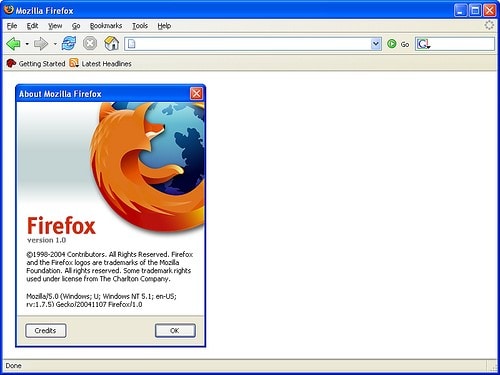
The Firefox browser has been a mainstay of the open-source community for a long time. For many years it was the default web browser on (almost) all Linux distros and the lone obstacle to Microsoft’s total dominance of the internet. This browser has roots that go back all the way to the very early days of the internet. Since this week marks the 30th anniversary of the internet, there is no better time to talk about how Firefox became the browser we all know and love.
Early Roots
In the early 1990s, a young man named Marc Andreessen was working on his bachelor’s degree in computer science at the University of Illinois. While there, he started working for the National Center for Supercomputing Applications. During that time Sir Tim Berners-Lee released an early form of the web standards that we know today. Marc was introduced to a very primitive web browser named ViolaWWW. Seeing that the technology had potential, Marc and Eric Bina created an easy to install browser for Unix named NCSA Mosaic). The first alpha was released in June 1993. By September, there were ports to Windows and Macintosh. Mosaic became very popular because it was easier to use than other browsing software.
In 1994, Marc graduated and moved to California. He was approached by Jim Clark, who had made his money selling computer hardware and software. Clark had used Mosaic and saw the financial possibilities of the internet. Clark recruited Marc and Eric to start an internet software company. The company was originally named Mosaic Communications Corporation, however, the University of Illinois did not like their use of the name Mosaic. As a result, the company name was changed to Netscape Communications Corporation.
The company’s first project was an online gaming network for the Nintendo 64, but that fell through. The first product they released was a web browser named Mosaic Netscape 0.9, subsequently renamed Netscape Navigator. Internally, the browser project was codenamed mozilla, which stood for “Mosaic killer”. An employee created a cartoon of a Godzilla like creature. They wanted to take out the competition.

They succeed mightily. At the time, one of the biggest advantages that Netscape had was the fact that its browser looked and functioned the same on every operating system. Netscape described this as giving everyone a level playing field.
As usage of Netscape Navigator increase, the market share of NCSA Mosaic cratered. In 1995, Netscape went public. On the first day, the stock started at $28, jumped to $75 and ended the day at $58. Netscape was without any rivals.
But that didn’t last for long. In the summer of 1994, Microsoft released Internet Explorer 1.0, which was based on Spyglass Mosaic which was based on NCSA Mosaic. The browser wars had begun.
Over the next few years, Netscape and Microsoft competed for dominance of the internet. Each added features to compete with the other. Unfortunately, Internet Explorer had an advantage because it came bundled with Windows. On top of that, Microsoft had more programmers and money to throw at the problem. Toward the end of 1997, Netscape started to run into financial problems.
Going Open Source

In January 1998, Netscape open-sourced the code of the Netscape Communicator 4.0 suite. The goal was to “harness the creative power of thousands of programmers on the Internet by incorporating their best enhancements into future versions of Netscape’s software. This strategy is designed to accelerate development and free distribution by Netscape of future high-quality versions of Netscape Communicator to business customers and individuals.”
The project was to be shepherded by the newly created Mozilla Organization. However, the code from Netscape Communicator 4.0 proved to be very difficult to work with due to its size and complexity. On top of that, several parts could not be open sourced because of licensing agreements with third parties. In the end, it was decided to rewrite the browser from scratch using the new Gecko) rendering engine.
In November 1998, Netscape was acquired by AOL for stock swap valued at $4.2 billion.
Starting from scratch was a major undertaking. Mozilla Firefox (initially nicknamed Phoenix) was created in June 2002 and it worked on multiple operating systems, such as Linux, Mac OS, Microsoft Windows, and Solaris.
The following year, AOL announced that they would be shutting down browser development. The Mozilla Foundation was subsequently created to handle the Mozilla trademarks and handle the financing of the project. Initially, the Mozilla Foundation received $2 million in donations from AOL, IBM, Sun Microsystems, and Red Hat.
In March 2003, Mozilla announced plans to separate the suite into stand-alone applications because of creeping software bloat. The stand-alone browser was initially named Phoenix. However, the name was changed due to a trademark dispute with the BIOS manufacturer Phoenix Technologies, which had a BIOS-based browser named trademark dispute with the BIOS manufacturer Phoenix Technologies. Phoenix was renamed Firebird only to run afoul of the Firebird database server people. The browser was once more renamed to the Firefox that we all know.
At the time, Mozilla said, “We’ve learned a lot about choosing names in the past year (more than we would have liked to). We have been very careful in researching the name to ensure that we will not have any problems down the road. We have begun the process of registering our new trademark with the US Patent and Trademark office.”

The first official release of Firefox was 0.8 on February 8, 2004. 1.0 followed on November 9, 2004. Version 2.0 and 3.0 followed in October 2006 and June 2008 respectively. Each major release brought with it many new features and improvements. In many respects, Firefox pulled ahead of Internet Explorer in terms of features and technology, but IE still had more users.
That changed with the release of Google’s Chrome browser. In the months before the release of Chrome in September 2008, Firefox accounted for 30% of all browser usage and IE had over 60%. According to StatCounter’s January 2019 report, Firefox accounts for less than 10% of all browser usage, while Chrome has over 70%.
The Future
As noted above, Firefox currently has the lowest market share in its recent history. There was a time when a bunch of browsers were based on Firefox, such as the early version of the Flock browser). Now most browsers are based on Google technology, such as Opera and Vivaldi. Even Microsoft is giving up on browser development and joining the Chromium band wagon.
This might seem like quite a downer after the heights of the early Netscape years. But don’t forget what Firefox has accomplished. A group of developers from around the world have created the second most used browser in the world. They clawed 30% market share away from Microsoft’s monopoly, they can do it again. After all, they have us, the open source community, behind them.
The fight against monopoly is one of the several reasons why I use Firefox. Mozilla regained some of its lost market share with the revamped release of Firefox Quantum and I believe that it will continue the upward path.
What event from Linux and open source history would you like us to write about next? Please let us know in the comments below.
If you found this article interesting, please take a minute to share it on social media, Hacker News or Reddit.
It's FOSS turns 13! 13 years of helping people use Linux ❤️
And we need your help to go on for 13 more years. Support us with a Plus membership and enjoy an ad-free reading experience and get a Linux eBook for free.
To celebrate 13 years of It's FOSS, we have a lifetime membership option with reduced pricing of just $76. This is valid until 25th June only.
If you ever wanted to appreciate our work with Plus membership but didn't like the recurring subscription, this is your chance 😃

